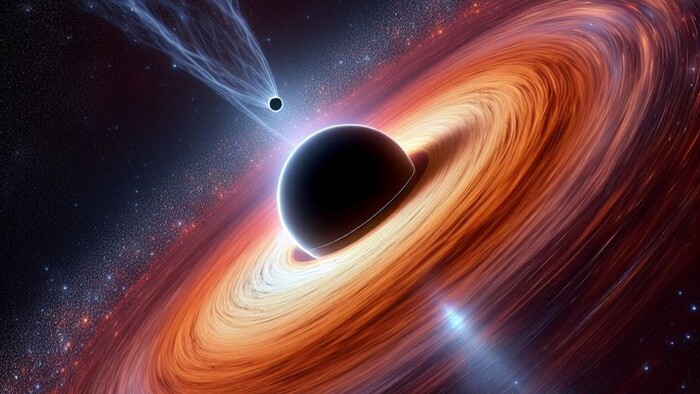A black hole with 'hiccups' was observed for the first time at the center of a galaxy 800 million light years away from us: for four months it emitted plumes of gas every 8.5 days, probably due to the presence of a second smaller black hole buzzing around it and which has periodically crossed its accretion disk, a possibility that had so far only been predicted theoretically. This is indicated by the study published in the journal Science Advances by astronomers from the Massachusetts Institute of Technology in collaboration with researchers from the Czech Republic and the University of Rome Tor Vergata.
If confirmed, this discovery could change the concept of the accretion disk of black holes, which until now was considered as a relatively uniform disk of gas rotating around the black hole. The results of the new study instead suggest that in some cases this disk could host other black holes and even stars.
What changed the game were the automatic observations made by a network of 20 robotic telescopes (All Sky Automated Survey for SuperNovae, Asas-Sn), always looking for supernovae and other transient phenomena. In December 2020 their lenses identified a glow coming from a galaxy 800 million light-years away that had until then remained quiet. Subsequent observations performed with NASA's Nicer X-ray telescope, mounted on board the International Space Station, allowed us to detect a periodicity of 8.5 days in the emissions in a narrow band of it is observed when a planet passes in front of the parent star, temporarily blocking its light.
Searching for an explanation for this unprecedented phenomenon, MIT researchers led by Dheeraj Pasham came into contact with some theoretical physicists from the Czech Republic, who had foreseen the possibility that a supermassive black hole at the center of a galaxy could host a second black hole smaller one which, moving along its orbit, periodically ends up crossing the accretion disk of the larger black hole: this phenomenon should cause the release of plumes of gas, like a bee flying through a cloud of pollen.
A first confirmation of this theory came from some simulations that researchers conducted using data from the Nicer telescope. According to their calculations, the supermassive black hole at the center of the galaxy has a mass equal to 50 million times that of the Sun, while the second smaller black hole is between 100 and 10,000 solar masses. In December 2020, a third object entered the scene, probably a star that got a little too close and ended up being torn apart by the gravity of the larger black hole. The sudden influx of stellar material temporarily illuminated the accretion disk. For four months the black hole feasted on stellar debris: in the meantime the second black hole continued to orbit, periodically crossing the accretion disk of the larger black hole, thus ending up generating the plumes detected by Nicer.
Reproduction reserved © Copyright ANSA

